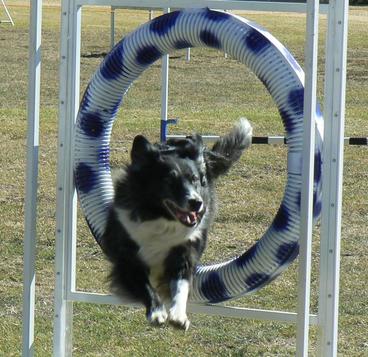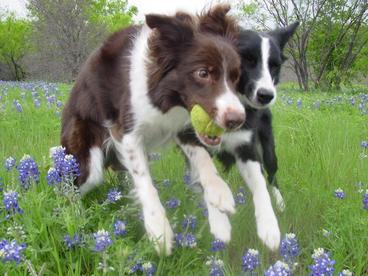
Border Collie collapse (BCC) is an episodic nervous system disorder that is triggered by strenuous exercise. BCC is recognized throughout North America, Europe, and Australia and is observed in dogs used for working stock, as well as dogs participating in agility or fly-ball competitions or repeatedly retrieving a ball. This disorder has also been called exercise induced collapse (EIC), exercise induced hyperthermia, stress seizures and "the wobbles".
Affected dogs are normal at rest and seem healthy. Typical collapse episodes begin 5 – 15 min after onset of exercise and include disorientation, dull mentation or loss of focus; swaying, staggering and falling to the side; exaggerated lifting of each limb while walking and a choppy gait; scuffing of the rear and/or forelegs, and crossing of the legs when turning. All of the factors contributing to the tendency for an affected dog to collapse on a given day (excitement, heat, intensity of exercise) have not been determined. Some dogs seem relatively normal while they are exercising but only show symptoms about 5 minutes after exercise is halted. Dogs are abnormal for 5 to 30 minutes, but then recover completely with no residual lameness or muscle stiffness or discomfort. Affected dogs are often unable to exercise and must be retired from competition and work.
Though first described in border collies, a similar collapse condition has been observed in other breeds, including:
- Australian Cattle Dog

- Australian Kelpie
- Australian Shepherd
- Bearded Collie
- Collie
- Miniature American Shepherd
- Shetland Sheepdog
VIDEO 1
Video 1
VIDEO 2
Video 2
VIDEO 3
Video 3
VIDEO 4
Video 4
THE PROJECT
The Project

Investigators at the the University of Minnesota (Dr. Jim Mickelson and Katie Minor), University of Saskatchewan (Drs. Susan Taylor and Cindy Shmon), and the University of California, San Diego (Dr. Diane Shelton) are involved in a large-scale project to investigate this disorder. The objectives of the project are to (1) establish clinical, hematologic and biochemical parameters for normal Border Collies participating in a standardized exercise protocol, (2) to evaluate dogs with BCC participating in a standardized exercise protocol to determine clinical or clinicopathologic markers for BCC at rest or after exercise that will help veterinarians diagnose BCC and help us understand the cause of collapse, (3) to fully describe the clinical features of BCC to facilitate recognition by dog owners and veterinarians, (4) to evaluate the heritability of BCC, (5) to determine the genetic cause of BCC, and (6) to develop a genetic test for BCC to aid diagnosis and to allow breeding decisions to be made to avoid producing affected pups.
Dr. Sue Taylor (University of Saskatchewan - Western College of Veterinary Medicine) has recently completed strenuous exercise studies (sheep herding and ball-chasing) with normal Border collies and dogs with BCC. Dogs with BCC have normal physical, orthopedic and neurologic examinations at rest. Dogs with BCC and normal Border collies develop alterations in rectal temperature, hematologic, biochemical, blood gas and acid base parameters that are very similar to those previously described in normal exercising Labrador retrievers. No abnormalities have been detected in serum electrolytes (sodium and potassium), blood sugar, blood cortisol, ability to ventilate, or heart rhythm that can explain the collapse in dogs with BCC. Dogs with BCC and normal Border collies all develop very high body temperatures (often >41.7C, >107F) after 10 minutes of strenuous exercise, but they cool down quickly when exercise is halted. Normal and BCC affected dogs are negative for the dynamin 1 mutation causing EIC in Labrador Retrievers. Thus far no differences between the normal dogs and the dogs with BCC have been identified except that the dogs with BCC exhibit gait and mentation abnormalities as described above. Dogs with BCC remain abnormal for 5 to 30 minutes, but then recover completely with no residual lameness or muscle stiffness or discomfort.
How can I tell BCC from heat exhaustion / heat stroke?
A commonly asked question is how to differentiate BCC episodes from recurrent heat exhaustion or heat stroke. For years, dogs with episodes of BCC have been labeled as “heat intolerant” because collapse is most likely to occur in hot weather. Dogs with BCC certainly are hot after exercise but their body temperatures are not higher than normal dogs performing the same exercise so it is not simply overheating causing collapse. Also it is important to recognize that the collapse episodes we see in dogs with BCC are very different from those associated with actual heat stroke. Heat stroke severe enough to cause mentation changes, gait abnormalities and collapse in a dog will be life-threatening and often fatal. Recovery, if it does occur, is slow and prolonged (hours to days) even with intensive treatment. Laboratory evaluation reveals a dramatic increase in the muscle enzyme CK and many affected dogs develop acute kidney failure. More than 80% of dogs collapsed due to heat stroke exhibit mentation changes that are severe, progressive and persistent (for hours to days). Damage to blood vessel walls leads to widespread clot formation, damage to multiple organs, low platelet numbers and often widespread bleeding. In contrast, dogs with BCC-related collapse episodes show no laboratory abnormalities and recover quickly – returning to normal within 5 to 30 minutes. Besides the severity of collapse episodes, the recurrent nature of BCC-related episodes and the fact that collapse can occur even on days with moderate or cool ambient temperatures helps to distinguish BCC from heat-related illness.
Managing an Affected Dog
Affected dogs can still live fairly normal lives but they may have to have their participation in trigger activities limited, especially in warm weather. Cooling vests and ice chips may also allow the dog to exercise for longer without showing signs of stress.
Dogs should be monitored closely so that exercise can be halted at the first sign of weakness/wobbliness or disorientation. If the dog does collapse:
- Make sure that it has unobstructed breathing so it can hyperventilate to blow off heat
- Offer water and ice orally
- Cool the dog by immersing it in cool water or wetting it down
- Enforce rest until the dog is fully recovered.
Until we know the underlying cause of these episodes there is no specific treatment that we can recommend to prevent BCC.
PARTICIPATE IN THE PROJECT
How can I help?

If your dog has had 2 or more episodes of collapse, we would like your help as we try to describe the syndrome and search for the genetic cause. Please take the time to download and fill out the Affected Dog Submission Form and send us a blood sample and pedigree from your affected dog. If you have a video of your dog having an episode, we would like to have the opportunity to view that as well.
We are also interested in collecting blood samples and pedigrees from exercise tolerant (normal) border collies for the genetic study. Ideally, normal dogs should be a minimum of five years of age with no reports of exercise intolerance or collapse when worked hard.
Funding

American Kennel Club Canine Health Foundation
This study has received previous support from the American Border Collie Association, the Australian Shepherd Health & Genetics Institute, the AKC Canine Health Foundation, and a grant from the Western College of Veterinary Medicine.
Scientific References
Heritability and Genomic Architecture of Episodic Exercise-Induced Collapse in Border Collies
Norton, Elaine M., Katie M. Minor, Susan M. Taylor, Molly E. McCue, and James R. Mickelson (2021). Genes 12, no. 12: 1927. doi: https://doi.org/10.3390/genes12121927
Evaluation of Dogs with Border Collie Collapse, Including Response to Two Standardized Strenuous Exercise Protocols
Susan Taylor, Cindy Shmon, Lillian Su, Tasha Epp, Katie Minor, James Mickelson, Edward Patterson, and G. Diane Shelton (2016). Journal of the American Animal Hospital Association doi: http://dx.doi.org/10.5326/JAAHA-MS-6361
Border Collie Collapse: Owner Survey Results and Veterinary Description of Videotaped Episodes
Susan Taylor, Katie Minor, Cindy L. Shmon, G. Diane Shelton, Edward E. Patterson, and James R. Mickelson (2016). Journal of the American Animal Hospital Association doi: http://dx.doi.org/10.5326/JAAHA-MS-6436